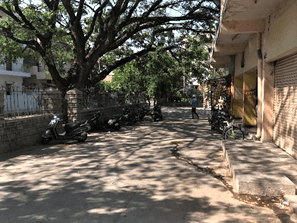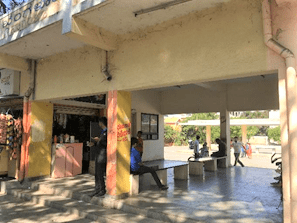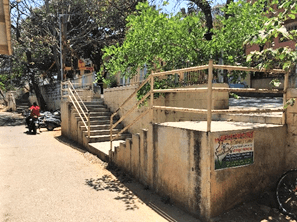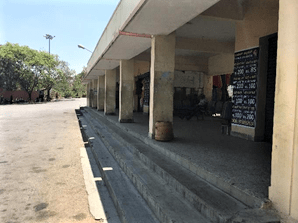[This article is part of the Bengaluru Moving series, in which citizens share their vision for BMTC post COVID. In this article, two researchers share their findings on easing bus commute for people with disabilities. The series is published in collaboration with Radio Active’s #BengaluruMoving campaign.]
Accessible and affordable public transport is central for persons with disability to lead dignified and active lives. Routine activities like work, healthcare, buying essential goods and maintaining a social life, are all dependent on their access to transport infrastructure.
Despite international charters like the UN Convention on the Rights of Persons with Disabilities (2008), national legislation like The Rights of Persons with Disabilities Act, 2016, and pan-India campaigns such as the Accessible India campaign (2015), public transport in India is still largely inaccessible for persons with disabilities.
Transport agencies such as the Bangalore Metropolitan Transport Corporation (BMTC) are part of these campaigns and are key to enabling barrier-free access. We would like to share some of the learnings from our recent research study. The research is part of an ongoing mobility project titled EQUIMOB: Inclusive Cities through Equitable Access to Urban Mobility.
Based on this research data, we would like to suggest the following to make bus infrastructure more inclusive.
Affordability
BMTC provides concessions in fares and special passes for persons with disabilities. These fares are relatively low compared to other modal options. But they are still expensive and do not uniformly cover all types of disabilities. For example, the full fare concession provided for visually challenged persons was not extended to other types of disabilities.
Also, BMTC does not provide the necessary physical infrastructure to access its buses. Affordability helps only when the infrastructure is accessible.
Inadequate physical infrastructure
Physical infrastructure refers to the universal design provisions (design that’d ensure access to everyone irrespective of ability, age, etc) as mandated by international conventions, charters, national legislations and Indian Roads Congress guidelines. Under the Accessible India campaign, 50 buildings in Bengaluru were set for physical infrastructure adaptation. Three of these were transportation hubs—-the Bande Maramma Bus Station, Chandra Layout Bus Station and the Nandini Layout Bus Station.
Here we briefly present the findings from visual surveys of Bande Maramma Bus Station and the Nandini Layout Bus Station to explain the state of physical infrastructure. When comparing the sites to the requirements set out for accessibility under the Accessible India Campaign, it becomes clear that there are many outstanding issues.
Site 1: Bande Maramma Bus Station

Figure 1 
Figure 2
Site 2: Nandini Layout Bus Station
Following are the results from our visual survey in comparison with the evaluation criteria under the Accessible India campaign.
| Evaluation criteria as per the Accessible India campaign | Infrastructure at Bande Maramma Bus Stop | Infrastructure at Nandini Layout Bus Stop |
| Well-lit bus shelters | – The bus station had standard street lighting in the courtyard – No lighting in the bus shelter | – Standard street lighting present in the courtyard and in front of the station – Lighting existed in the station |
| Footpaths with even surface for movement of mobility-aid users, and continuous tactile paving stones for persons with visual impairment | – Pavements were not even – No tactile paving stones present | – The footpaths were incomplete and contain some major barriers – No tactile pavers used |
| Bus shelters with barrier-free access, having defined boarding gates with warning tiles | – Neither the bus stop nor bus shelter were barrier-free, and had steps-only access – No defined boarding gates – No warning tiles – No mobility aids or other facilities available to users | – The bus station was not barrier-free and had step-only access – No defined boarding gates – No warning tiles – No mobility aids or other facilities available to users |
| Provision of Braille signage and audible messages on signage panels | – No signage present in Braille – No evidence of audible messages | – No signage present in Braille. – No evidence of audible messages – All signage out of date or poorly maintained |
Both the transport hubs – Bande Maramma Bus Station and Nandini Layout Bus Station – severely lack universal design despite being part of the Accessible India campaign. The state of other transport hubs is similar or much worse. Supporting infrastructure like lighting, even surface pavements, wheelchair-friendly barrier-free access, provisions for Braille signage and audible messages require immediate attention. Additionally, a dedicated assistant or volunteer present at all major bus hubs to assist persons with disabilities will be beneficial.
Partial access is no access
The Accessible India campaign states as one of its targets that ‘25% of government-owned public transport carriers in the country are converted into fully accessible carriers by March 2020’. BMTC is guided by this mandate as well. This target to achieve partial access compounds barriers amidst the general inadequacy of buses, bus shelters and supporting infrastructure.
A person with a disability will have to do extensive research about the exact bus routes and bus stops/stations/terminus which are equipped with universal designs, before leaving home. Such information is not readily available or updated regularly. Partial access also eliminates specific bus routes and geographical areas, thus limiting the travel radius for persons with disability.
In the short term, BMTC needs to make readily available information on the specific bus routes and bus stops which are accessible for persons with disabilities. Further, there should be periodic monitoring and evaluation of the existing infrastructure.
Also, an accessibility index needs to be prepared for each of the transport hubs for evaluation. These index scores will help persons with disabilities plan their trips appropriately and confidently. The index will also help BMTC identify transport hubs for upgradation.
No accessible infrastructure inside the bus
The bus and its interior too need to be conducive to those using a wheelchair. BMTC has a low-floor, wheelchair-friendly facility only for the premium AC (Vayu Vajra) buses but not for its regular buses. The current high-raise steps are a major deterrent for persons on a wheelchair to enter the bus. Further, the two seats earmarked for persons with disabilities need to have enough room for a wheelchair.
Overall, the lack of properly designed physical infrastructure in buses is a major barrier for persons with disabilities, and needs redressal.
Participatory planning
Most importantly, persons with disabilities are often only seen as end-users of BMTC. There is a need to engage with persons with disabilities and NGOs in the disability sector at different stages of implementing a new project, procurement process or while evaluating bus-related infrastructure. Such engagement will enable a robust feedback mechanism and will ensure BMTC stays aware of the needs of persons with disabilities at all stages.
Overall, although there are numerous frameworks, campaigns and funding initiatives, the bus infrastructure needs significant modification to be accessible. BMTC needs to adopt a travel-chain concept (travel-chain involves a series of trips between two anchor points, like home and office) to understand the difficulties faced along first and last mile connectivity in transport hubs and the experience in the bus itself.
In all of these, participatory planning will be crucial in providing a safe, accessible, and inclusive bus system for Bengaluru.
[Funding Source Declaration: This work is part of the research project ‘Inclusive Cities through Equitable access to Urban Mobility Infrastructures for India and Bangladesh’ (PI: Prof. A. Bailey) under the research programme Joint Sustainable Development Goal research initiative with project number W 07.30318.003, which is financed by the Dutch Research Council (NWO) and Utrecht University, The Netherlands.]
Also Read:
► Bus travel in times of COVID: How BMTC can accommodate senior citizens
► Remember Bengaluru’s minimal traffic during lockdown? Here are nine pointers to sustain it
► How should BMTC buses be run now, given social distancing challenges?



